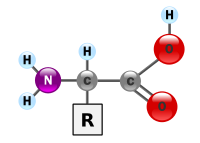
Use of a solid‐state nanopore for profiling the transferrin receptor protein and distinguishing between transferrin receptor and its ligand protein
Sign Up to like & getrecommendations! Published in 2022 at "ELECTROPHORESIS"
DOI: 10.1002/elps.202200147
Abstract: A nanopore device is capable of providing single‐molecule level information of an analyte as they translocate through the sensing aperture—a nanometer‐sized through‐hole—under the influence of an applied electric field. In this study, a silicon nitride… read more here.
Keywords: ligand protein; receptor protein; transferrin receptor; solid state ... See more keywords

Multiresolution non-covalent interaction analysis for ligand–protein promolecular electron density distributions
Sign Up to like & getrecommendations! Published in 2021 at "Theoretical Chemistry Accounts"
DOI: 10.1007/s00214-020-02705-w
Abstract: Nowadays, the topology of electron density (ED) distributions as well as the non-covalent interaction (NCI) analysis of reduced density gradient (RDG) distributions, are extensively used to characterize intermolecular contacts. Here, topological and NCI-based analyses are… read more here.
Keywords: ligand protein; electron density; density distributions; density ... See more keywords

Prediction of the Drug-Target Binding Kinetics for Flexible Proteins by Comparative Binding Energy Analysis
Sign Up to like & getrecommendations! Published in 2021 at "Journal of chemical information and modeling"
DOI: 10.1021/acs.jcim.1c00639
Abstract: There is growing consensus that the optimization of the kinetic parameters for drug-protein binding leads to improved drug efficacy. Therefore, computational methods have been developed to predict kinetic rates and to derive quantitative structure-kinetic relationships… read more here.
Keywords: protein; energy; analysis; ligand protein ... See more keywords

De Novo Molecule Design Using Molecular Generative Models Constrained by Ligand-Protein Interactions
Sign Up to like & getrecommendations! Published in 2022 at "Journal of chemical information and modeling"
DOI: 10.1021/acs.jcim.2c00177
Abstract: In recent years, molecular deep generative models have attracted much attention for its application in de novo drug design. The data-driven molecular deep generative model approximates the high dimensional distribution of the chemical space through… read more here.
Keywords: interaction; ligand protein; generative models; design ... See more keywords

Halogen Bonds in Ligand–Protein Systems: Molecular Orbital Theory for Drug Design
Sign Up to like & getrecommendations! Published in 2020 at "Journal of Chemical Information and Modeling"
DOI: 10.1021/acs.jcim.9b00946
Abstract: Halogen bonds are highly important in medicinal chemistry as halogenation of drugs, generally, improves both selectivity and efficacy toward protein active sites. However, accurate modeling of halogen bond interactions remains a challenge, since a thorough… read more here.
Keywords: ligand protein; drug; halogen; molecular orbital ... See more keywords

Anisotropic Friction in a Ligand-Protein Complex
Sign Up to like & getrecommendations! Published in 2023 at "Nano Letters"
DOI: 10.1021/acs.nanolett.2c04632
Abstract: The effect of an externally applied directional force on molecular friction is so far poorly understood. Here, we study the force-driven dissociation of the ligand-protein complex biotin-streptavidin and identify anisotropic friction as a not yet… read more here.
Keywords: protein complex; anisotropic friction; friction; ligand protein ... See more keywords

Coupling Supervised Molecular Dynamics (SuMD) with Entropy Estimations To Shine Light on the Stability of Multiple Binding Sites.
Sign Up to like & getrecommendations! Published in 2019 at "ACS medicinal chemistry letters"
DOI: 10.1021/acsmedchemlett.8b00490
Abstract: Exploring at the molecular level, all possible ligand-protein approaching pathways and, consequently, identifying the energetically favorable binding sites is considered crucial to depict a clear picture of the whole scenario of ligand-protein binding. In fact,… read more here.
Keywords: binding sites; multiple binding; ligand protein; molecular dynamics ... See more keywords

The Role of Loop Dynamics in the Prediction of Ligand-Protein Binding Enthalpy
Sign Up to like & getrecommendations! Published in 2023 at "Chemical Science"
DOI: 10.1039/d2sc06471e
Abstract: The enthalpic and entropic components of ligand-protein binding free energy reflect the interactions and dynamics between ligand and protein. Despite decades of study, our understanding and hence our ability to... read more here.
Keywords: protein binding; dynamics prediction; ligand protein; loop dynamics ... See more keywords

Perspectives on High-Throughput Ligand/Protein Docking With Martini MD Simulations
Sign Up to like & getrecommendations! Published in 2021 at "Frontiers in Molecular Biosciences"
DOI: 10.3389/fmolb.2021.657222
Abstract: Molecular docking is central to rational drug design. Current docking techniques suffer, however, from limitations in protein flexibility and solvation models and by the use of simplified scoring functions. All-atom molecular dynamics simulations, on the… read more here.
Keywords: protein; throughput ligand; protein docking; perspectives high ... See more keywords

Hydrogen Bonds with Fluorine in Ligand–Protein Complexes-the PDB Analysis and Energy Calculations
Sign Up to like & getrecommendations! Published in 2022 at "Molecules"
DOI: 10.3390/molecules27031005
Abstract: Fluorine is a common substituent in medicinal chemistry and is found in up to 50% of the most profitable drugs. In this study, a statistical analysis of the nature, geometry, and frequency of hydrogen bonds… read more here.
Keywords: energy; analysis; ligand protein; fluorine ligand ... See more keywords

Ligand’s Partition to the Lipid Bilayer Should Be Accounted for When Estimating Their Affinity to Proteins
Sign Up to like & getrecommendations! Published in 2023 at "Molecules"
DOI: 10.3390/molecules28073136
Abstract: Ligand-protein interactions are usually studied in complex media that also contain lipids. This is particularly relevant for membrane proteins that are always associated with lipid bilayers, but also for water-soluble proteins studied in in vivo… read more here.
Keywords: affinity; lipid bilayer; ligand protein;